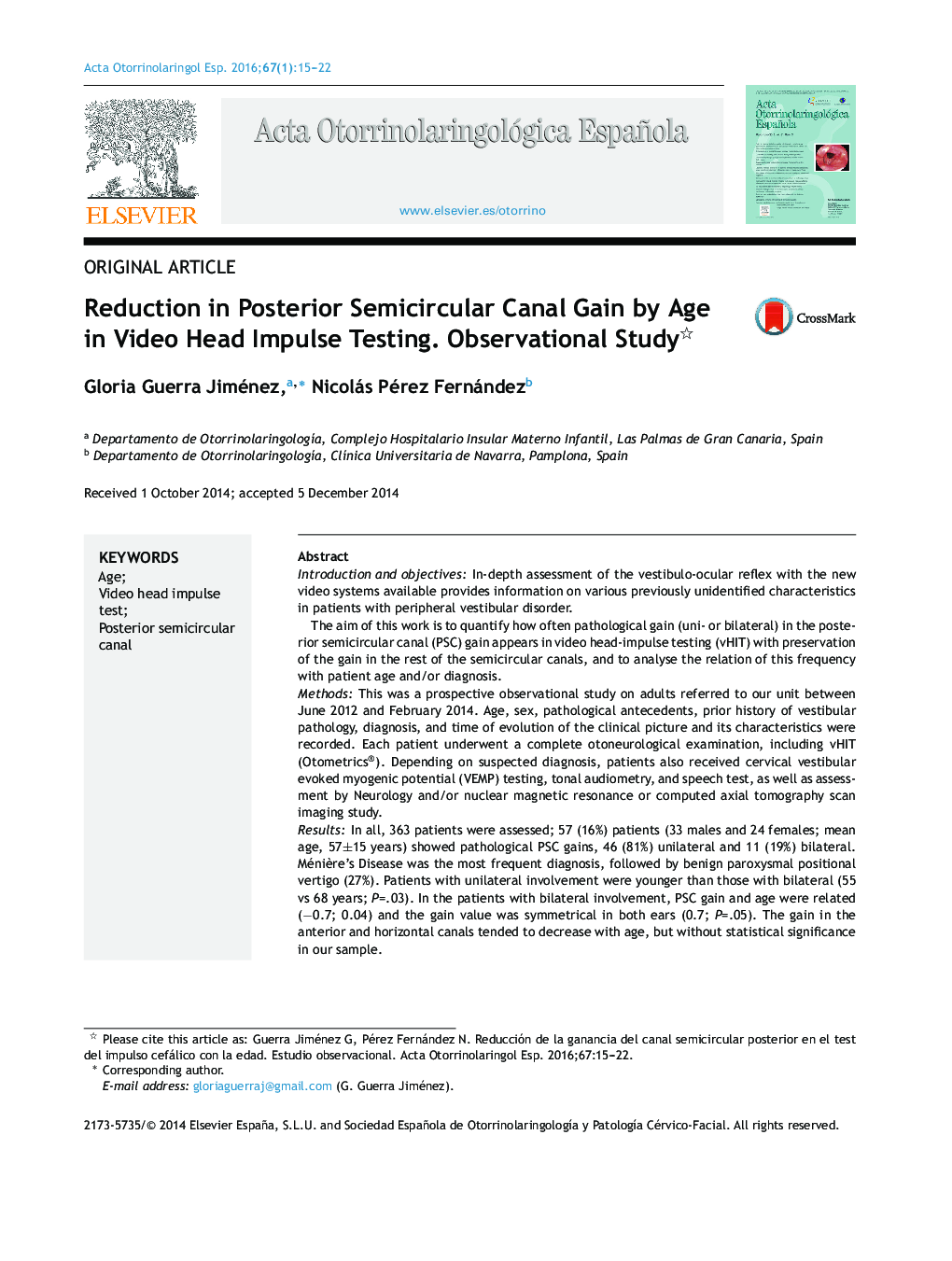| Article ID | Journal | Published Year | Pages | File Type |
|---|---|---|---|---|
| 4100683 | Acta Otorrinolaringologica (English Edition) | 2016 | 8 Pages |
Introduction and objectivesIn-depth assessment of the vestibulo-ocular reflex with the new video systems available provides information on various previously unidentified characteristics in patients with peripheral vestibular disorder.The aim of this work is to quantify how often pathological gain (uni- or bilateral) in the posterior semicircular canal (PSC) gain appears in video head-impulse testing (vHIT) with preservation of the gain in the rest of the semicircular canals, and to analyse the relation of this frequency with patient age and/or diagnosis.MethodsThis was a prospective observational study on adults referred to our unit between June 2012 and February 2014. Age, sex, pathological antecedents, prior history of vestibular pathology, diagnosis, and time of evolution of the clinical picture and its characteristics were recorded. Each patient underwent a complete otoneurological examination, including vHIT (Otometrics®). Depending on suspected diagnosis, patients also received cervical vestibular evoked myogenic potential (VEMP) testing, tonal audiometry, and speech test, as well as assessment by Neurology and/or nuclear magnetic resonance or computed axial tomography scan imaging study.ResultsIn all, 363 patients were assessed; 57 (16%) patients (33 males and 24 females; mean age, 57±15 years) showed pathological PSC gains, 46 (81%) unilateral and 11 (19%) bilateral. Ménière's Disease was the most frequent diagnosis, followed by benign paroxysmal positional vertigo (27%). Patients with unilateral involvement were younger than those with bilateral (55 vs 68 years; P=.03). In the patients with bilateral involvement, PSC gain and age were related (−0.7; 0.04) and the gain value was symmetrical in both ears (0.7; P=.05). The gain in the anterior and horizontal canals tended to decrease with age, but without statistical significance in our sample.ConclusionsOf the patients referred for an otoneurological consultation, 16% showed pathological PSC gain (unilateral in 81% and bilateral in 19% of the cases). This gain involvement was attributable to age when the gain was bilateral and symmetrical.
ResumenIntroducción y objetivosLa evaluación detallada del reflejo vestíbulo-ocular con los nuevos sistemas de vídeo disponibles, proporciona información sobre algunas características no identificadas previamente en pacientes con vestibulopatía periférica.El objetivo de este trabajo es cuantificar la frecuencia de aparición de ganancias patológicas, uni- o bilaterales, del canal semicircular posterior (CSP) en la prueba de impulso cefálico vídeo asistida (vHIT) con preservación de la ganancia en el resto de los canales semicirculares, y analizar su relación con la edad y/o el diagnóstico del paciente.MétodosEstudio prospectivo observacional en adultos entre junio de 2012 y febrero de 2014. Se analizó la edad, género, antecedentes patológicos, historia previa de patología vestibular, diagnóstico, tiempo de evolución del cuadro clínico y sus características. Se completó un examen otoneurológico completo, un vHIT (Otometrics®), y según la sospecha, potenciales evocados vestibulares miogénicos cervicales (cVEMP), audiometría tonal, logoaudiometría así como una evaluación por Neurología y/o un estudio de imagen.ResultadosTrescientos sesenta y tres pacientes fueron evaluados: 57 (16%) pacientes (33 varones, 24 mujeres, edad media 57 ± 15 años) mostraron ganancias patológicas del CSP, 46 (81%) unilateral y 11 (19%) bilateral. El diagnóstico más frecuente fue la enfermedad de Ménière, seguido del VPPB (27%). Los pacientes con afectación unilateral son más jóvenes que los pacientes con afectación bilateral (55 vs 68 años; p = 0,03). En los pacientes con afectación bilateral, la ganancia del CSP es simétrica en ambos oídos (0,7; p = 0,05) y se relaciona inversamente con la edad (-0,7; 0,04) y el valor de ganancia. La ganancia de los canales anteriores y horizontales tiende a disminuir con la edad, pero sin significación estadística en nuestra muestra.ConclusionesEl 16% de los pacientes remitidos a una consulta de otoneurología muestran ganancias patológicas del CSP, unilateral en el 81% y bilateral en el 19% de los casos. Esta afectación de la ganancia es atribuible a la edad cuando es bilateral y simétrica.
